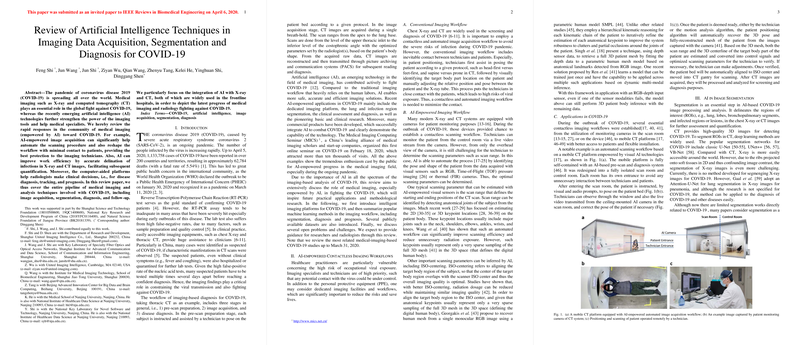Review of Artificial Intelligence Techniques in Imaging Data Acquisition, Segmentation, and Diagnosis for COVID-19
This paper provides a comprehensive review of AI techniques applied in medical imaging to fight COVID-19. The research addresses several critical components: image acquisition, segmentation, and diagnosis, demonstrating how AI enables more efficient and safer medical imaging workflows, especially during a pandemic.
AI-Empowered Contactless Imaging Workflows
The paper begins by highlighting the vulnerability of healthcare practitioners and the need for contactless imaging workflows to minimize viral exposure. Traditional imaging workflows necessitate direct contact between technicians and patients during the scanning process, leading to high risks of infection transmission.
AI has been instrumental in automating these processes. Modern X-ray and CT systems, equipped with cameras for patient monitoring, have integrated AI to automate patient positioning and scanning. This automation reduces technician-patient contact, significantly lowering the risk of infection. Furthermore, AI can optimize scanning parameters, ensuring high-quality imaging while minimizing radiation exposure. These AI-driven innovations streamline the imaging process and enhance safety for medical personnel.
AI in Image Segmentation
Segmentation is a crucial step in COVID-19 image analysis, enabling the delineation of regions of interest (ROIs) such as lungs and infection sites. The paper discusses classic segmentation networks like U-Net, UNet++, and VB-Net, which have shown efficacy in segmenting lung regions and lesions in CT and X-ray images.
For instance, U-Net and its variants are widely adopted for their ability to capture both high-level semantics and fine details, crucial for accurate segmentation in medical imaging. The authors note the integration of human-in-the-loop strategies and weakly-supervised methods to overcome the challenge of limited labeled data. This hybrid approach ensures robustness and accuracy, essential for clinical applications.
AI-Assisted Diagnosis
The paper reviews several studies employing AI for diagnosing COVID-19 from imaging data. Deep learning models, particularly Convolutional Neural Networks (CNNs), have been employed to distinguish COVID-19 from other pneumonias and healthy subjects. The authors cite various models, including ResNet50 and Bayesian Convolutional Neural Networks, that have demonstrated high accuracy and specificity in clinical settings.
The results span multiple datasets and imaging modalities. For example, Chi et al. employ a CNN-based model with a UNet++ segmentation network to diagnose COVID-19, achieving over 95% accuracy. These studies underscore the potential of AI to assist radiologists by reducing reading times and increasing diagnostic accuracy.
Applications in COVID-19
Various applications of AI in COVID-19 are explored:
- Diagnosis: AI systems can quickly and accurately distinguish COVID-19 from other conditions like pneumonia. Notable results include the work of Chen et al., who achieve 100% sensitivity using a UNet++ and CNN combined model.
- Quantification: Segmentation methods provide quantitative data for monitoring disease progression, assessing inflammation, and aiding in clinical decision-making.
Theoretical and Practical Implications
The integration of AI into medical imaging workflows for COVID-19 has substantial implications:
- Practical: By automating time-consuming tasks and reducing human contact, AI improves the safety and efficiency of imaging procedures. This is particularly vital during pandemics, where minimizing exposure and managing increased patient volumes are critical.
- Theoretical: The advancements in AI-driven image analysis extend beyond COVID-19, offering frameworks that can be adapted to other diseases and conditions. The development of more accurate and robust AI models, particularly through weakly-supervised and transfer learning methods, is an essential area for future research.
Speculation on Future Developments in AI
While the current focus is on COVID-19, the methodologies discussed have broader implications for AI in healthcare. Future developments may include more sophisticated AI models that integrate various data types, such as imaging, clinical, and laboratory data, to provide comprehensive diagnostic and prognostic insights. With ongoing improvements in AI algorithms and data availability, the potential for AI to revolutionize medical imaging and healthcare at large is significant.
Conclusion
The paper outlines the pivotal role of AI in enhancing medical imaging for COVID-19, covering image acquisition, segmentation, and diagnosis. The integration of AI not only expedites and improves diagnostics but also protects healthcare professionals. As AI technologies continue to evolve, their application in medical imaging will undoubtedly expand, offering promising avenues for improved patient care and healthcare efficiency.
